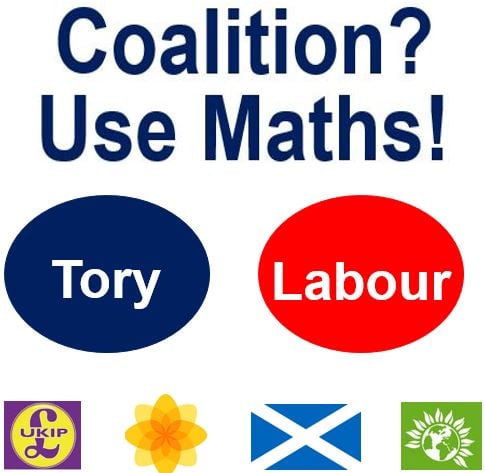Whoever thought of using mathematics to determine whether a political party should form a coalition? One Italian mathematician professor does, and says his model can deduce whether political particles should form coalitions under a range of circumstances.
In a paper published in March in the SIAM Journal of Applied Mathematics (citation below), Fabio Bagarello, professor of mathematical physics at the University of Palermo, Department of Mathematical Models, Palermo, Italy, proposes mathematical models to analyze political decision making.
He says his model’s dynamical approach accounts for interactions between parties and their constituents, and tries to deduce if and when parties should form coalitions.

Parties should use mathematics to decide whether to form a coalition.
Prof. Bagarello said:
“Mathematics is important in many aspects of social behavior. Politics is just one of these aspects, since some of the typical behavior in politics can be characterized by suitable quantities which, usually, evolve in time. In other words, political parties are examples of dynamical systems.”
Prof. Bagarello uses a Hamiltonian operator, which can describe interactions among a number of constituents of a system. The model considers three parties in a system. Each party can either decide to form a coalition or go it alone.
This gives rise to a total of eight different possibilities that over time can change. The time behavior of ‘decision functions’ of the parties is then determined, which describes the probability of a party forming a coalition.
Model factors in interactions with voters
In order to come to a decision, the parties need to interact with electors or voters. This contributes to its final decision. The model considers this via an open system which takes into account voter interaction.
Prof. Bagarello said:
“Quite often, these kinds of dynamical systems are described by differential equations whose different terms describe different phenomena. In my approach the main ingredient is not the differential equation, but a Hamiltonian operator from which the dynamics of some relevant ‘observable’ of the system can be deduced.”
“This allows an easy way to model an ‘open system’ in which few actors (the parties) interact with many (the voters), and we can show how voters direct the behavior of the various parties.”
Bagarello added:
“Several macroscopic systems have been analyzed using such operatorial techniques. I have adopted the same general framework in the description of ‘love affairs’, migrations, closed ecological systems and simplified stock markets.”
“Dealing with stock markets was my original interest, due to the fact that traders exchange discrete quantities which are well described by simple and well-known algebraic rules.”
Future research may eventually help parties determine not only whether they should form an alliance, but with whom.
Prof. Bagarello said:
“This is part of a possible extended version of the model, and work in progress. The model could also be improved by adding some nonlinearities in the interaction terms. These could be used, for instance, to produce a more refined model in which the parties’ behaviors are significantly driven by the decisions of other parties.”
Citation: “An Operator View on Alliances in Politics,” Fabio Bagarello. SIAM J. Appl. Math. Published online 19 March, 2015. DOI: 10.1137/140990747.

